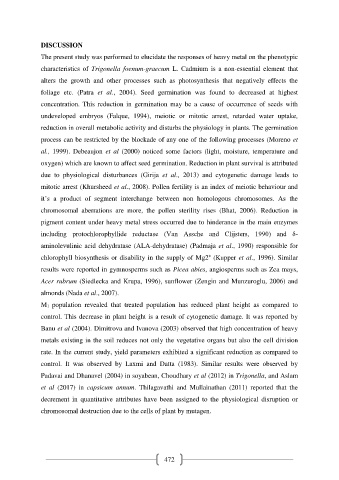Page 482 - e-Book
P. 482
DISCUSSION
The present study was performed to elucidate the responses of heavy metal on the phenotypic
characteristics of Trigonella foenum-graecum L. Cadmium is a non-essential element that
alters the growth and other processes such as photosynthesis that negatively effects the
foliage etc. (Patra et al., 2004). Seed germination was found to decreased at highest
concentration. This reduction in germination may be a cause of occurrence of seeds with
undeveloped embryos (Falque, 1994), meiotic or mitotic arrest, retarded water uptake,
reduction in overall metabolic activity and disturbs the physiology in plants. The germination
process can be restricted by the blockade of any one of the following processes (Moreno et
al., 1999). Debeaujon et al (2000) noticed some factors (light, moisture, temperature and
oxygen) which are known to affect seed germination. Reduction in plant survival is attributed
due to physiological disturbances (Girija et al., 2013) and cytogenetic damage leads to
mitotic arrest (Khursheed et al., 2008). Pollen fertility is an index of meiotic behaviour and
it’s a product of segment interchange between non homologous chromosomes. As the
chromosomal aberrations are more, the pollen sterility rises (Bhat, 2006). Reduction in
pigment content under heavy metal stress occurred due to hinderance in the main enzymes
including protochlorophyllide reductase (Van Assche and Clijsters, 1990) and δ-
aminolevulinic acid dehydratase (ALA-dehydratase) (Padmaja et al., 1990) responsible for
+
chlorophyll biosynthesis or disability in the supply of Mg2 (Kupper et al., 1996). Similar
results were reported in gymnosperms such as Picea abies, angiosperms such as Zea mays,
Acer rubrum (Siedlecka and Krupa, 1996), sunflower (Zengin and Munzuroglu, 2006) and
almonds (Nada et al., 2007).
M1 population revealed that treated population has reduced plant height as compared to
control. This decrease in plant height is a result of cytogenetic damage. It was reported by
Banu et al (2004). Dimitrova and Ivanova (2003) observed that high concentration of heavy
metals existing in the soil reduces not only the vegetative organs but also the cell division
rate. In the current study, yield parameters exhibited a significant reduction as compared to
control. It was observed by Laxmi and Datta (1983). Similar results were observed by
Padavai and Dhanavel (2004) in soyabean, Choudhary et al (2012) in Trigonella, and Aslam
et al (2017) in capsicum annum. Thilagavathi and Mullainathan (2011) reported that the
decrement in quantitative attributes have been assigned to the physiological disruption or
chromosomal destruction due to the cells of plant by mutagen.
472

